FalconSat-7
Non-EO
Mission complete
USAF
Education
Quick facts
Overview
| Mission type | Non-EO |
| Agency | USAF |
| Mission status | Mission complete |
| Launch date | 25 Jun 2019 |
| End of life date | 02 Jul 2021 |
FalconSat-7
Spacecraft Launch Sensor Complement Ground Segment References
FalconSat-7 is a nanosatellite program of the USAFA (United States Air Force Academy) in Colorado Springs (CO, USA) where cadets design, build, launch and operate their own small satellite. Many departments are involved in the program including physics and astronautical engineering, electrical engineering and mechanical engineering. The AFIT (Air Force Institute of Technology), Wright-Patterson AFB, Ohio, is participating in this project.
FalconSat-7 (FS-7) is a student technology demonstration mission to test a solar space telescope, an enabling technology incorporating a membrane photon sieve deployed from a 3U CubeSat to image the sun. The primary optic is a photon sieve - a diffractive optic consisting of billions of tiny circular pads on a transparent polymer substrate. 1) 2) 3) 4) 5)
The goals of the FS-7 program are:
• Cadets learn space by doing space
• Deploy a photon sieve telescope from a folded configuration
• Get flight heritage on a polyimide photon sieve
• Image the sun in the hydrogen alpha band in order to examine the chromosphere
• Determine the imaging performance of a photon sieve in space.
The primary optic is a 0.2 m Ø photon sieve – a diffractive element, consisting of billions of tiny holes in an otherwise opaque polymer sheet. The membrane, its support structure, secondary optics, two imaging cameras and associated control/recording electronics are all packaged within half the CubeSat volume. Once in space, the supporting pantograph structure is deployed to pulling the membrane flat under tension. The telescope will then be steered towards the Sun to gather images at H-alpha for transmission to the ground. 6) 7)
FalconSAT-7 will serve as a pathfinder for future missions in low-mass, high-resolution spaceborne surveillance applications. Surveillance imagery can always benefit from larger primary apertures, but physical limits are now being reached on the size of monolithic (or even segmented) reflectors that can be put in orbit. Ensuring a diffraction limited surface is one issue, but more fundamentally, there are limits on the mass and volume of satellites imposed by launch vehicles. This is reflected in the plot of current and past commercial and scientific space telescopes shown in Figure 1 (blue). In order to break this trend, the FS-7 project is investigating the possibility of membrane diffractive optics, where the surface requirements are greatly relaxed and the primary can be compacted into a very small volume. New missions, based on this technology, will make it possible to significantly reduce cost, with apertures (and hence resolutions) previously thought unobtainable (Figure 1, red). Furthermore, with high packing ratios, the project can begin to construct extremely compact satellites that are simple to manufacture and launch in large numbers with short lead times.
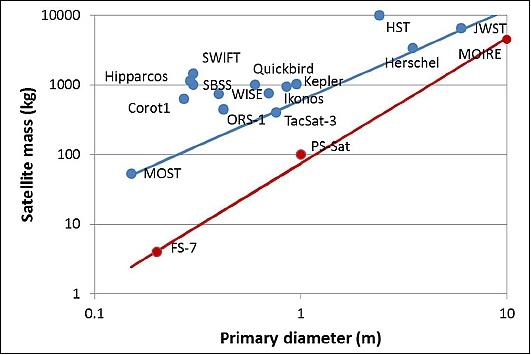
Spacecraft
Cadets and staff at the Air Force Academy in collaboration with others at NASA, AFIT (Air Force Institute of Technology) and AFRL (Air Force Research Laboratory) and with support from the NRO (National Reconnaissance Office) and DARPA (Defense Advanced Research Projects Agency ), are constructing FalconSat-7: a 3U CubeSat solar observatory in LEO (Low Earth Orbit).
FalconSAT-7 is a 3U CubeSat nanosatellite measuring just 30 cm x 10 cm x 10 cm with a mass of ~ 5 kg. The satellite is built on a NRO supplied Colony-II 3U CubeSat built by Boeing. The payload is Peregrine: the world's first spaceborne membrane telescope.
Half of the 3U CubeSat volume is devoted to bus avionics. Within the remaining volume the project has configured a payload which consists of the membrane, deployment structure, secondary optics (including secondary lenses, baffles, filter and fold mirrors) two cameras, and electronics.
In order to point at the Sun, the spacecraft will be 3-axis controlled. With a 0.5º pointing accuracy (2σ) assumed for the CubeSat, analysis indicates that the sun will be in the FOV (Field of View) of the telescope system 56% of the time. There are several commercial solutions for providing this level of pointing accuracy; for example Maryland Aerospace's MAI-400 ADCS (Attitude Determination and Control Subsystem) unit.

The successful deployment of the photon sieve enables the next mission objective, imaging the sun. This goal tests the end-to-end system including the operation of the photon sieve, bus control, and payload pointing.
The payload deployment structure consists of three spring-load pantographs stowed under compression and the catenary shaped membrane gently folded inside the center. Once in orbit, the hinged end panel opens by the release of a burn wire and the pantographs deploy automatically. The membrane is pulled to the required flatness by a 0.5 N radial tension provided by the pantographs and upper lanyards that form a tensioned upper hexapod. The positioning of the photon sieve depends critically on the lengths of these lanyards which form a determinate system. The photon sieve is de-coupled from the pantographs by springs. In order for the pantographs to deploy without interference from the bus structure, they are mounted to a carriage plate that moves the entire deployment system to the end of the bus. The carriage plate positioning is also critical for optical positioning of the photon sieve and is held in place by a second tensioned lower hexapod. The tension for the lower hexapod is provided by springs.
FS-7 will be deployed from a P-POD and after deployment of the solar panels and initial check-out of the bus, the photon sieve membrane will be deployed from the end of the CubeSat.
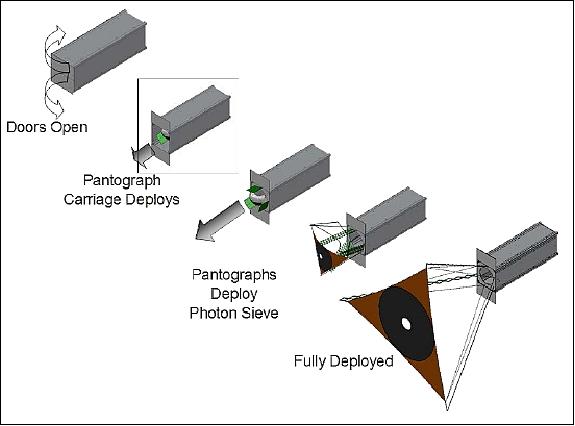
The FS-7 deployment system is based on a two-stage, spring-loaded deployment mechanism. This mechanism was designed to accommodate the volume and size constraints of the payload. In the first stage of the deployment system, the assembly moves linearly out of the bus. The second stage is held in place using three sequencing bars. Once the bottom of the assembly clears the top of the bus, the sequencing bars all disengage and allow the second stage of the deployment. During the second stage of the deployment 3 precision pantograph arms extend to their final position, putting tension on the photon sieve and ensuring high-quality imagery.
Because the deployment of the photon sieve is critical for meeting all of our operational objectives, the FalconSat -7 program relies on significant experimental validation of the system. This testing process has allowed the team to do hundreds of deployments to ensure that the characteristics of the deployment are known, and the program will be successful on orbit.
The first of these tests started with the engineering model of the deployment system. This system was designed and built by MMA Design LLC in Boulder, CO in early 2012. During the summer of 2012, the system experienced dozens of deployments to understand the stowing process of the system, and how to repeatedly deploy the system to compare results. These deployments led up to a NASA Zero-G flight in August of 2012, more favorably known as the "Vomit Comet", Figure 4. This flight produced successful Zero-G deployments, proving to the team that the system works in a low gravity environment.
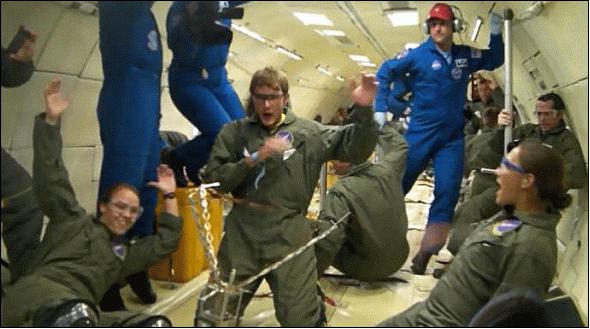
The spacecraft will Sun-soak for most of the orbit that is not in eclipse. An initial analysis indicates that slewing from a Sun-soak attitude to a Sun-imaging attitude and subsequent relaxation of thermal gradient induced and ADCS maneuvering vibrations will take approximately one minute. This will be done each orbit in order to collect one image per revolution. Slewing as necessary will be done to download images to the ground. Each image will take 6 minutes to download.
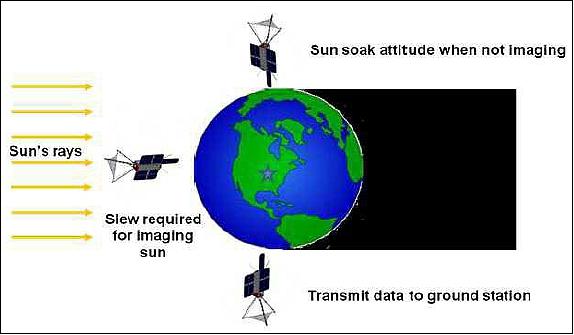
Development Status
• In April 2015, the project plans to deliver FS‐7 to the STP (Space Test Program) for launch integration in late 2015.
• In July 2014, the project completed environmental testing on our qualification model according to the General Environmental Verification Specification (GEVS).
Launch
FalconSat-7 is a secondary payload on the STP-2 rideshare mission of USAF, launched on 25 June 2019 (06:30 UTC) aboard a SpaceX Falcon Heavy launch vehicle from Launch Complex 39A at NASA's Kennedy Space Center. The STP-2 payload includes six FormoSat-7/COSMIC-2 satellites (primary payload, each with a mass of 280 kg), developed by NOAA and Taiwan's National Space Organization to collect GPS radio occultation data for weather forecasting. The mission also carries several NASA technology demonstrations. The STP-2 mission is led by the Air Force Space Command's Space and Missile Systems Center (SMC). The total IPS (Integrated Payload Stack) has a mass of 3700 kg. 8)
Secondary Payloads
• DSX (Demonstration and Science Experiments) mission of AFRL
• GPIM (Green Propellant Infusion Mission), a demonstration minisatellite of NASA (~180 kg). 9)
• FalconSat-7, a 3U CubeSat mission developed by the Cadets of the U.S. Air Force Academy (USAFA) at Colorado Springs, CO.
• NPSat-1 (Naval Postgraduate School Satellite-1) of the Naval Postgraduate School, Monterey, CA. A microsatellite of 86 kg.
• OCULUS-ASR (OCULUS-Attitude and Shape Recognition), a microsatellite (70 kg) of MTU (Michigan Technological University), Houghton, MI, USA.
• Prox-1, a microsatellite (71 kg) of SSDL (Space Systems Design Laboratory) at Georgia Tech.
• LightSail-2 of the Planetary Society, a nanosatellite (3U CubeSat, 5 kg) will be deployed from the parent satellite Prox-1.
• ARMADILLO of UTA (University of Texas at Austin), a nanosatellite (3U CubeSat) of ~ 4 kg.
• E-TBEx (Enhanced Tandem Beacon Experiment), a tandem pair (3U CubeSats) of SRI International.
• TEPCE (Tether Electrodynamics Propulsion CubeSat Experiment), a 3U CubeSat (3 kg) of NPS (Naval Postgraduate School).
• CP-9 , a joint CP-9/StangSat experiment, which is a collaboration between PolySat at Cal Poly and the Merritt Island High School, and is sponsored by the NASA LSP (Launch Services Program). CP-9 is a 2U CubeSat while StangSat is a 1U CubeSat.
• PSat-2 (ParkinsonSAT), a student built 1.5U CubeSat of USNA (US Naval Academy) with a mass of 2 kg.
• BRICSAT-2, a student built 1.5U CubeSat of USNA (US Naval Academy) to demonstrate a µCAT electric propulsion system and carry a ham radio payload.
• OTB-1 (Orbital Test Bed-1) a minisatellite developed by SSTL (based on the SSTL-150 bus, 138 kg) and owned by General Atomics' Electromagnetic Systems Group (GA-EMS) of San Diego. One of the hosted payloads is NASA's DSAC (Deep Space Atomic Clock), a technology demonstration mission with the goal to validate a miniaturized, ultra-precise mercury-ion atomic clock that is 100 times more stable than today's best navigation clocks.
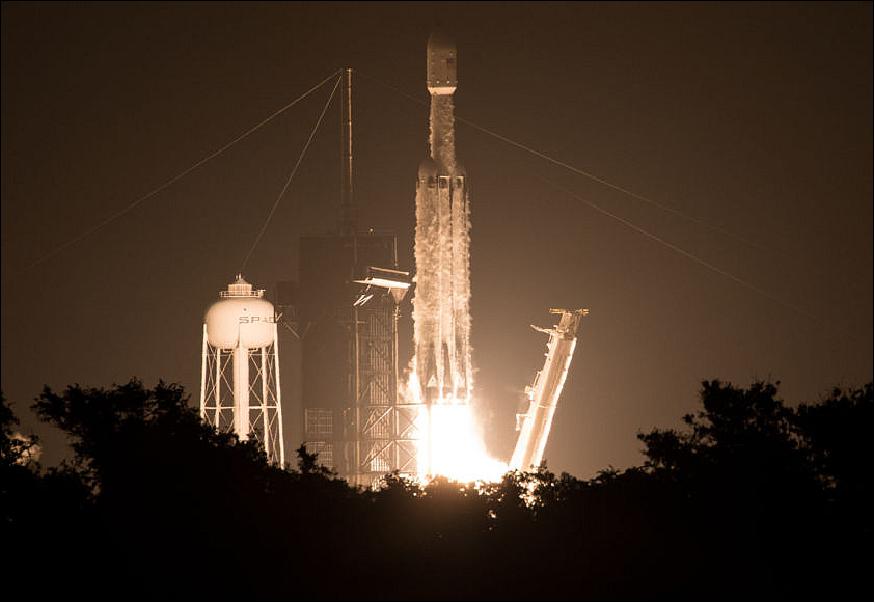
Orbits
The STP-2 mission will be among the most challenging launches in SpaceX history with four separate upper-stage engine burns, three separate deployment orbits, a final propulsive passivation maneuver and a total mission duration of over six hours. It will demonstrate the capabilities of the Falcon Heavy launch vehicle and provide critical data supporting certification for future National Security Space Launch (NSSL) missions. In addition, [the USAF] will use this mission as a pathfinder for the [military's systematic utilization of flight-proven] launch vehicle boosters.
The three orbits of the STP-2 mission for spacecraft deployment are:
1) The small secondary CubeSat satellites will be deployed into an elliptical orbit of ~300 x 860 km, inclination of ~28º. These are: OCULUS-ASR, TEPCE, E-TBEx, FalconSat-7, ARMADILLO, PSAT-2, BRICSAT, and CP-9/StangSat.
2) The second deployment batch of the STP-2 mission will occur at a circular altitude of 720 km and an inclination of 24º.
- Deployment of LightSail-2, Prox-1, and NPSat-1
- Deployment of OTB-1 with NASA's DSAC and GPIM
- The six FormoSat-7/COSMIC-2 satellites will be deployed into the initial circular parking orbit of 720 km. Eventually, they will be positioned in a low inclination orbit at a nominal altitude of ~520-550 km with an inclination of 24º (using their propulsion system). Through constellation deployment, they will be placed into 6 orbital planes with 60º separation.
3) The third and final deployment will be the Air Force Research Lab's DSX spacecraft as well as the ballast, which will be delivered to an elliptical MEO (Medium Earth Orbit) with a perigee of 6000 km and an apogee of 12000 km, inclination of 43º.
Sensor Complement (PS, Peregrine)
PS (Photon Sieve)
Some background on PS characteristics: The telescope technology has only incrementally improved in areal density since the beginning of spaceborne imagery. For example, the HST (Hubble Space Telescope) has a mirror with a specific mass (or areal density) of 180 kg/m2, while the JWST (James Webb Space Telescope) has reduced this to just 25 kg/m2 over a quarter of a century later. Not only is size an issue, but the cost of fabricating surfaces to the high degree of precision required results in telescope costs scaling roughly as the diameter to the power of 1.75 (D1.75). Added to this, there is still the issue of packing large monolithic structures into limited launch vehicle volumes. 10) 11) 12) 13) 14)
The membrane photon sieve technology has several advantages over that of a primary mirror or lens used in traditional imaging systems. First, the material is made on a flexible membrane that can be folded. This allows for deployed apertures with a diameter larger than the satellite bus. Second, the PS (Photon Sieve) surface requirement is around two orders of magnitude less stringent than that of traditional optical surfaces. Third, the PS is extremely lightweight. With the use of polyimide membranes the project is aiming at areal densities of 0.25 kg/m2 — a game-changing 3 orders of magnitude improvement above the current state-of-the-art. This comes along with similar savings in fabrication a materials cost.
Photon Sieves
The photon sieve is the heart of the optical system. The USAFA (United States Air Force Academy) has been working on photon sieve technology for the past 8 years. They are constructed on aluminum-coated polyimide films that are strong, rollable, and light. To create an image, 2.5 billion depressions are photo-lithographically etched on the surface forming images in essentially the same manner as a Fresnel lens. The pattern used for FS-7 is shown in Figure 7 (left). To maintain diffraction-limited performance, the sieve must be flat to within about 10 times the wavelength of light. This constraint is significantly relaxed from the surface quality required for refractive or reflective optical elements, which must maintain a surface quality of about 1/10 of a wavelength. Despite this simplification to the surface quality requirement, the deployment of the photon sieve must be exceptionally precise for the optical system to produce high-quality imagery.
A photon sieve is essentially a FZP (Fresnel Zone Plate) in which the rings have been broken up into isolated circular holes. For an infinite conjugate, binary FZP of focal length at a wavelength λ, the radial distance to the center of the nth bright zone is given by rn= 2nfλ+f2λ2.
In its simplest version, the PS consists of holes of diameter rn located at the corresponding radial distance rn. The holes can be distributed regularly or randomly in angle about the zone. It has since been found that the diameter of the holes can be increased to an optimum value of 1.514 times the underlying zone width, greatly relaxing the fabrication constraints.
The project investigated many types of photon sieve designs at USAFA. Early prototypes were created in chrome-coated quartz using electron-beam photolithography (Figure 7). For a typical 10 cm diameter sieve with a 1 m focal length, there were up to 10 million holes ranging in size from 8-260 µm. Many different variations have been tested including those for multiwavelength operation and others configured to arbitrary conic constants. The project has also investigated phase versions to increase the efficiency towards the theoretical limit of ~40%.
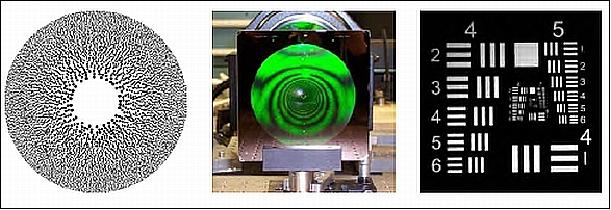
Further research has led to photon sieves in flexible membrane substrates with the most recent prototypes being photo-lithographically patterned, aluminum-coated polyimide films that are strong, rollable and light. These membrane materials have demonstrated near-zero CTE (Coefficient of Thermal Expansion), which is crucial for avoiding issues with pattern distortion in the changing thermal environment experienced in orbit.
Perhaps the most significant advantage for using a diffracting optic over either a refracting (lens) or reflecting (mirror) primary is that the substrate need not be pulled to an optical flatness. The height of the largest bump h can be calculated as h< 8∅(f/D)2. So for a transmitted wavefront error of λ/10, an f/2 photon sieve must have a flatness maintained to approximately 3λ. By comparison, the surface requirements for a reflector would be some 60 times more stringent. Along with the reduction in mass, this easing of engineering constraints is one of the major reasons for pursuing the photon sieve technology. The drawback, however, is the limited bandwidth.
The PS is a diffractive element and, as such, suffers from dispersion, which results in a wavelength dependent focal length. Using depth of focus considerations,it was found that images will remain in focus over a bandwidth given by Δλ=2fλ2/D2. Making the PS aperture size larger obviously provides better diffraction limited imaging. On the other hand, making the photon sieve larger decreases the optical bandwidth. For Peregrine (D = 0.2 m, f = 0.4 m, λ = 656.3 nm) the bandwidth is only 8.6 picometer (pm), but for Solar observations, there will be sufficient photon flux to permit imaging. Future missions aimed at Earth surveillance will include corrective optics to greatly improve the bandwidth.
The project plan calls for the fabrication of the photon sieves in Novastrat polyimide manufactured by Nexolve of Huntsville, AL. This material has been space-tested and can be chemically "tuned" to just about any desired CTE. Films of transparent polymer will be spun to a thickness of around 25 µm. While the surface deformation constraints are quite loose compared to conventional optics, the project has to ensure a high degree of thickness uniformity as the light will be transmitted through the substrate. Nexolve has demonstrated control to the thickness constraints necessary for the needs of the project.
Peregrine (optical system)
Peregrine is an innovative solar space telescope with a membrane aperture of 20 cm which will be deployed from a from the end of a 3U CubeSat to image the sun. The telescope consists of deployable structure that supports the membrane under tension. The membrane is a photon sieve – a diffractive element with over 2.5 billion holes. The size and position of each hole is configured such that transmitted light is diffracted to a focal plane array within the CubeSat. 15)
The photon sieve will have the following design parameters (Ref. 4):
• 200 mm diameter, 400 mm focal length, 656.45 nm wavelength
• 2.5 billion holes ranging in size from 2-277 µm
• 50% fill factor, 30% focusing efficiency
The telescope has a relatively simple design due to space constraints and has:
• 4 µrad resolution which equates to 600 km at the sun surface
• ~0.1º field of view (about a 1/5th of the sun's disk)
• 1 Å spectral bandwidth.
Peregrine is the first-ever deployable telescope payload for nanosatellites. It is comprised of four subsystems: membrane primary optical element [developed and patented by a Department of Physics LORC (Laser and Optics Research Center) researcher], deployment structure, optical platform containing the secondary optics and primary camera, and payload electronics and software (Figure 8). The membrane, deployment and support structure, secondary optics, cameras, and associated payload electronics and power management systems were designed and constructed for a 1.5U volume and have a mass of <1.7 kg. The membrane optical element and deployment structure subsystems are tightly linked with regards to the overall optical performance of the telescope.
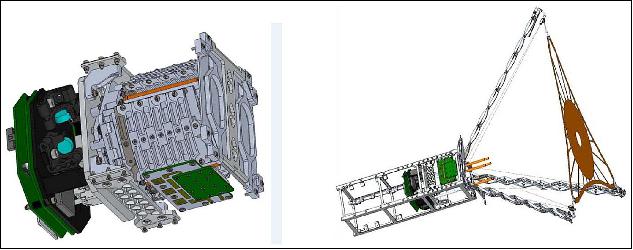
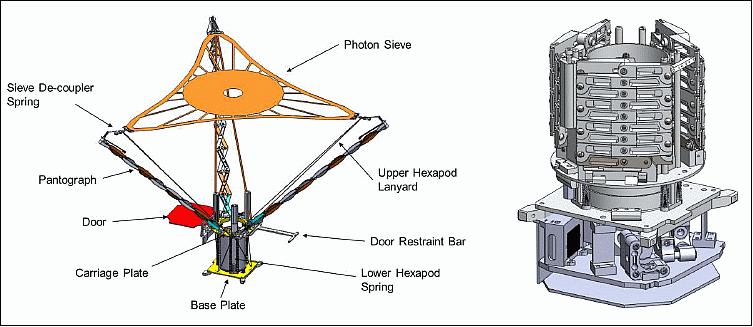
The secondary optics of the photon sieve telescope (Figure 10) collimate the focused beam from the photon sieve for transmission through a narrowband Andover filter (1.5 Å FWHM, 35% peak transmission) and change the effective f-number of the system to f/10. The narrowband hydrogen alpha filter eliminates the majority of non-focused light at the FPA (Focal Plane Array) of the camera. The collimated beam is approximately 10 mm in diameter, and the final focal distance from the second lens to the camera focal plane is about 100 mm. The three fold mirrors after the final lens are not shown.

The optical system of the FalconSAT-7 peregrine payload consists of eight elements. A flexible membrane primary focuses light at 40 cm. A 12 mm achromatic doublet with 15 mm focal length is used to collimate the light coming from the primary followed by a Fabry Perot bandpass filter with a 0.1 nm bandwidth centered at 656.45 nm to eliminate unwanted wavelengths. A second achromatic doublet with a 100 mm focal length focuses the image on the camera (Figure 11 and Figure 12). Three fold mirrors are used to direct this beam to an 8 bit monochrome CMOS camera (Ref. 5).
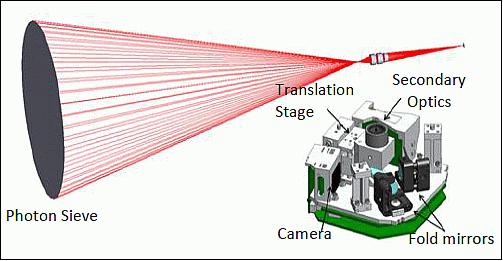
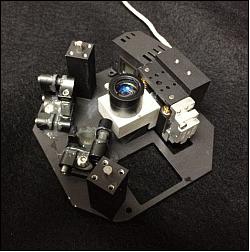
The project uses Zemax optical software to simulate images of the sun as seen by FalconSat-7. The left image of Figure 13 shows a photo of the sun taken on July 31, 2012 that is 0.14º in angular size or 0.59 arcsec/pixel. This image was produced by the SDO (Solar Dynamic Observatory) and closely matches the FOV and resolution of the photon sieve imaging capabilities (0.139º, 1360 x 1024 pixels, 0.37 arcsec/pixel). This image was then used for the Peregrine telescope performance analysis in Zemax software. This Zemax model included the effects of diffraction and aberrations through the photon sieve and secondary optics.
For the FalconSat-7 proof-of-concept mission, the deployable membrane telescope will be used for narrow-band imaging of the sun's chromosphere at the hydrogen-alpha spectral line of 656.46 nm (vacuum wavelength). The FalconSat-7 telescope technologies could enable affordable, very large space-based solar observatories with imaging resolutions sufficient to understand the small-scale spatial dynamical structures of the sun's chromosphere that contribute to the formation of solar flares and CMEs (Coronal Mass Ejections).
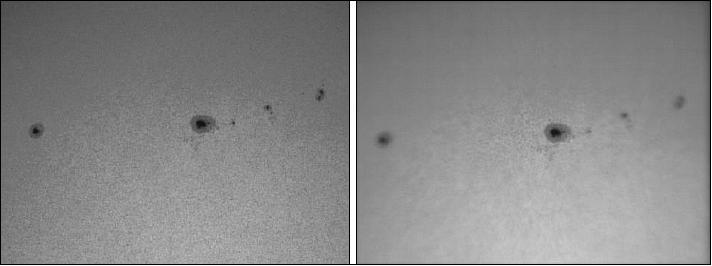
Peregrine electronics:
The Peregrine electronics must provide C&C (Command and Control) of the payload, as well as data handling. The C&C requirements include the operation of the main CCD camera and inspection camera, FPGA (Field Programmable Gate Array) control, and movement and reading of the translation (focusing) stage. Figure 14 is a block diagram of the payload electronics.
The payload C&C electronics have been developed in-house [SPARC (Space Physics and Atmospheric Research Center)] and packaged onto two printed circuit boards, each less than 82 mm x 82 mm and less than 1.5 cm high. Some of the design has flown successfully on orbit with other SPARC payloads. The remainder has been purchased as COTS components with some repackaging to fit the restrictive form factors of a CubeSat or designed from scratch specifically for FalconSAT-7 specifications.
Central to the payload electronics is an Atmel AVR32 microcontroller. The AVR controls a Xilinx Spartan 3AN FPGA which captures the digital images from the Sentech CCD camera at rates up to 19 frames per second, saves the images to intermediate random-access memory, and provides a buffer for transmitting images back through the AVR to a 2 GB secure digital memory card, used for flash storage (storage for approximately 700 images). Configuring the FPGA on orbit can be accomplished with the AVR. The microcontroller also (i) operates the melt wire circuitry which activates the membrane photon sieve deployment; (ii) controls the main CCD camera analog and digital gains, scanning, binning, and exposure settings (10 µs and longer); (iii) using a digitizer, executes and downloads images from the deployment inspection camera; (iv) drives and records positional information from the focusing stage of the optical platform; and (v) communicates with the CubeSat bus via a 422 asynchronous bus.
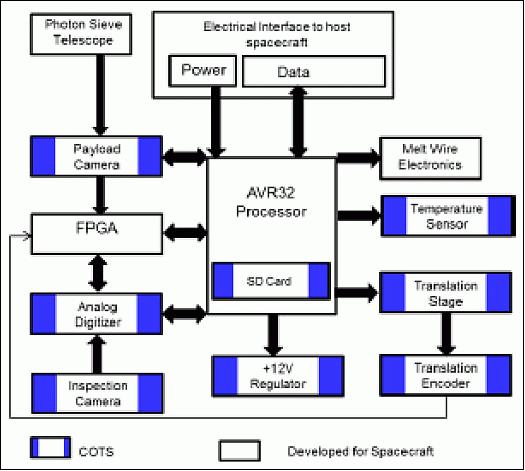
SPARC personnel and Departments of Physics, Astronautics, Electrical and Computer Engineering, and Management faculty and students, working with USAF, DoD, NASA, and industry partners, are constructing and testing the Peregrine payload for integration with a 3U CubeSat.
The mission goal for this payload is to demonstrate the effectiveness of deployable membrane photon sieve telescopes for spaceborne imaging missions. The membrane photon sieve technology can potentially be scaled to large apertures (up to 20 m) and hosted on larger spacecraft. Most of the analysis and optical-mechanical modeling of the payload has been completed along with a large amount of laboratory testing. Results to date indicate the Peregrine payload will achieve acceptable imaging performance on orbit and thus successfully demonstrate the technologies for space-based deployable membrane telescopes.
Ground Segment
The FalconSAT-7 ground segment uses the University MC3(Mobile CubeSat Command and Control) network running Neptune Common Ground Architecture (Neptune/CGA). This is Government Off-The-Shelf software developed by NRL (Naval Research Laboratory) to provide a command and control software suite capable of supporting satellite development throughout the life cycle of integration and test, launch and early orbit commissioning, and nominal operations. Currently, the FalconSAT-7 program is using Neptune/CGA extensively in the payload integration phase, but progress is underway in developing test suites for integrated satellite testing at the AFIT (Air Force Institute of Technology), Dayton, OH. On-orbit operations of FalconSAT-7 using Neptune/CGA running on the University MC3 ground station network will be executed by the NPS (Naval Postgraduate School) in Monterey, CA. The University MC3 is a network of fully autonomous ground stations located around the globe across the United States from Hawaii to Florida (Ref. 5).
Environmental testing: Before the flight version of FalconSAT-7 is launched, a lengthy environmental test campaign will be completed that is focused on first qualifying the payload and later the complete spacecraft. First, a qualification version of the payload will undergo a sequence of sine-sweep/random/sine-sweep vibration tests in a Cal-Poly Test-POD on AFIT's MB Dynamics slip table shaker. These vibration tests are performed to determine if all of components in the payload can survive the harsh vibration environment expected during launch. Next, the payload will undergo thermal-vacuum (TVac) tests in which the payload will be exposed to high vacuum (10-5 Torr) and a wide range of temperatures (±45ºC). The payload will be operated from the bus to ensure full functionality at all stages of the TVac tests to test its performance in a space-like environment.
References
1) Michael E. Dearborn, Geoff Andersen, Matthew G. McHarg, Jeff Harvey, "FalconSat-7: A Deployable Solar Telescope Mission," Proceedings of the 63rd IAC (International Astronautical Congress), Naples, Italy, Oct. 1-5, 2012, paper: IAC-12-B4.6B.1
2) Geoff Andersen, "Membrane diffractive space telescopes," URL: http://www.darpa.mil/WorkArea/DownloadAsset.aspx?id=2147485149
3) Samantha Latch, "Peregrine: A deployable solar imaging CubeSat mission," 9th Annual Spring CubeSat Developer's Workshop, Cal Poly State University, San Luis Obispo, CA, USA, April 18-20, 2012, URL: http://mstl.atl.calpoly.edu/~workshop/archive/2012/Spring/47-Latch-Peregrine.pdf
4) "FalconSAT-7," USAFA, URL: http://www.usafa.edu/df/dfe/dfer/centers/lorc/docs/FalconSAT07.pdf
5) Matthew G. McHarg, Brian A. Smith, Timothy H. Russell, Olha Asmolova, Trey S Quiller, Richard L Balthazor, Michael E. Dearborn, Brooke M. Isch, Taylor R. Johnson, Angus J. MacDonald, Eric W. Peek, Christopher Lomanno, Christopher Sheffield, Eric D. Swenson, "FalconSAT-7—A Deployable Solar Telescope," Proceedings of the AIAA/USU Conference on Small Satellites, Logan, Utah, USA, August 2-7, 2014, paper: SSC14-III-1, URL: http://digitalcommons.usu.edu/smallsat/2014/AdvTechI/1
6) Geoff Andersen, Olha Asmolova, Geoff McHarg, Michael Dearborn, Trey Quiller, "FalconSAT-7: Towards rapidly deployable space-based surveillance," AMOS (Advanced Maui Optical and Space Surveillance) Technologies Conference, Wailea Beach, Maui, Hawaii, USA, Sept. 10-13, 2013, URL: http://www.amostech.com/TechnicalPapers/2013/Space-Based_Assets/ANDERSEN.pdf
7) Brian A. Smith, Geoff P. Andersen, Olha Asmolova, Anthony J. Hillesheim, Matthew G. McHarg, Jacob K. Snow, "FalconSAT‐7, A Deployable Membrane Optic Telescope," 31st Space Symposium, Colorado Springs, CO, USA, April 13-16, 2015, URL: http://www.spacesymposium.org/sites
/default/files/downloads/B.Smith_31st_Space_Symposium_Tech_Track_paper.pdf
8) Stephen Clark, "Falcon Heavy launches on military-led rideshare mission, boat catches fairing," Spaceflight Now, 25 June 2019, URL: https://spaceflightnow.com/2019/06/25
/falcon-heavy-launches-on-military-led-rideshare-mission-boat-catches-fairing/
9) "GPIM Spacecraft to Validate Use of 'Green' Propellant," NASA, Aug. 19, 2014, URL: http://www.nasa.gov/content/gpim-spacecraft-to-validate-use-of-green-propellant/
10) Geoff Andersen, Michael Dearborn, Geoff McHarg, "FalconSAT-7: A Photon Sieve Solar Telescope," AMOS (Advanced Maui Optical and Space Surveillance) Technologies Conference, Wailea Beach, Maui, Hawaii, USA, Sept. 13-16, 2011, URL: http://www.amostech.com/TechnicalPapers/2011/Optical_Systems/ANDERSEN.pdf
11) "Photon Sieve to Fly on Cubesat," NASA, URL: http://gsfctechnology.gsfc.nasa.gov/Photon%20Sieve.html
12) Lori Keesey, "Emerging Optics Technology to Fly on Microsatellite," NASA/GSFC, June 4, 2012, URL: http://www.nasa.gov/topics/technology/features/kitchen-optics_prt.htm
13) Lori Keesey, "Emerging Optics Technology to Fly on Microsatellite," NASA, June 4, 2012, URL: http://www.nasa.gov/topics/technology/features/kitchen-optics.html
14) Olha Asmolova, Geoff Andersen, Michael E. Dearborn, Matthew G. McHarg, Trey Quiller, Thomas Murphey, "Optical Analysis of a Membrane Photon Sieve Space Telescope," Sensors and Systems for Space Applications VI, Proceedings of The International Society for Optical Engineering (SPIE), Edtitors:.K. D. Pham, J. L. Cox, R.T. Howard, G. Chen, Vol. 8739, 87390C, May 21, 2013, doi:10.1117/12.2015416
15) Rex R. Kiziah, Francis K. Chun, Michael E. Dearborn, Matthew G. McHarg, "Air Force Academy Department of Physics Space Technologies Development and Research," Proceedings of the 30th Space Symposium, Technical Track, Colorado Springs, CO, USA, May 19-22, 2014, URL: http://spacesymposium.org/sites/default/files/downloads
/R.Kiziah_30th_Space_Symposium_Tech_Track.pdf
The information compiled and edited in this article was provided by Herbert J. Kramer from his documentation of: "Observation of the Earth and Its Environment: Survey of Missions and Sensors" (Springer Verlag) as well as many other sources after the publication of the 4th edition in 2002. - Comments and corrections to this article are always welcome for further updates (eoportal@symbios.space).
Spacecraft Launch Sensor Complement Ground Segment References Back to top